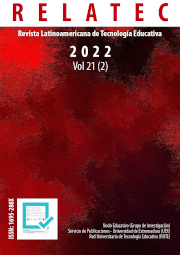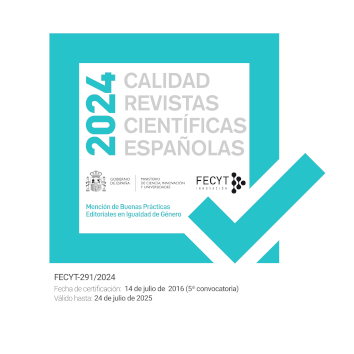Educational interventions with robots for students on the autism spectrum. A systematic review
DOI:
https://doi.org/10.17398/1695-288X.21.2.27Keywords:
Systematic Review, Autism Spectrum Disorders, Socio-Educational Robotics, Intervention, InclusionAbstract
This article describes the quantitative results of a study whose objective is to identify trends and opportunities for innovation in the field of socio-educational robotics to work with students with autism spectrum disorders. For the systematic review, those experiences and interventions where the protagonist is the student body have been considered. The focus is on their needs, not on the robot. Interventions that have been carried out where robots have been used as a teaching tool, whose design is aimed at the specific learning needs of this group. In order to find out if these interventions are integrative or segregating, both the characteristics of an excellent didactic practice aimed at this specific group and the inclusive point of view have been taken into account when making the analysis. For this, a systematic literature review has been carried out using a rigorously defined search strategy. This search has been carried out in the following databases; Web of Science, Eric and Dialnet, since they are the most used and relevant in education. In the results obtained, it is possible to identify the advances in didactic models based on the use of robotics as an educational tool. Pedagogical activities carried out in recent years, and didactic resources; evaluation criteria, strategies and instruments, as well as application experiences in real school contexts.
Downloads
References
Aguilar, L. A. (1991). El informe warnock. Cuadernos de pedagogía, 197, 62-64. https://blocs.xtec.cat/educacioespecialssdh/files/2009/01/informe-warnock.PDF
Ainscow, M., Slee, R., & Best, M. (2019). the Salamanca Statement: 25 years on. https://www.tandfonline.com/doi/full/10.1080/13603116.2019.1622800
American Psychiatric Association. (2013). Diagnostic and statistical manual of mental disorders (5th ed.). Arlington, VA. https://journals.sagepub.com/doi/full/10.1177/0306624X13511040?casa_token=Ey8PtRL5-k0AAAAA:-tQEi-Y44fZ3t5pRnYgUhNZtOjBB45ydMvPVtWF-ciJM4JqYsta3xPeEOrM4xoMLEt7CtKCakv-N
Arias Pujol, E & Mestres Martorell, M. (2012). Intervenión grupal con pre-adolescentes con autismo de alto funcionamiento. Cuadernos de psiquiatría y psicoterapia del niño y del asolescente, 54, 53-60. https://www.sepypna.com/documentos/articulos/arias-pujol-intervencion-grupal-preadolescentes-autismo.pdf
Arnaiz, P., Escarbajal, E., Caballero., C. M. (2017). El impacto del contexto escolar en la inclusión educativa. Revista de Educación Inclusiva, 10(2), 195-210. https://revistaeducacioninclusiva.es/index.php/rei/article/view/334
Artigas-Pallarés, J. (2011). ¿ Sabemos qué es un trastorno? Perspectivas del DSM 5. Rev Neurol, 52(Supl 1), S59-S69. https://www.researchgate.net/profile/Josep-Artigas/publication/221942040_Do_we_know_what_a_disorder_is_Prospects_of_the_DSM_5/links/5c702d83299bf1268d1dfca7/Do-we-know-what-a-disorder-is-Prospects-of-the-DSM-5.pdf
Artigas-Pallarès, J., & Paula, I. (2012). El autismo 70 años después de Leo Kanner y Hans Asperger. Revista de la Asociación Española de Neuropsiquiatría, 32(115), 567-587. https://scielo.isciii.es/scielo.php?script=sci_arttext&pid=S0211-57352012000300008
Beetz, A., Uvnäs-Moberg, K., Julius, H., & Kotrschal, K. (2012) Psychosocial and psychophysiological effects of human-animal interactions: the possible role of oxytocin. Front. Psychology 3:234. https://www.frontiersin.org/articles/10.3389/fpsyg.2012.00234/full
Chung, E. Y. H. (2021). Robot-Mediated Social Skill Intervention Programme for Children with Autism Spectrum Disorder: An ABA Time-Series Study. International Journal of Social Robotics, 13(5), 1095-1107. https://link.springer.com/article/10.1007/s12369-020-00699-w
Degener, T., & Begg, A. (2017). From invisible citizens to agents of change: A short history of the struggle for the recognition of the rights of persons with disabilities at the United Nations. In The United Nations convention on the rights of persons with disabilities (pp. 1-39). Springer, Cham. https://link.springer.com/chapter/10.1007/978-3-319-43790-3
De la Iglesia Gutiérrez, M., & Olivar, J. S. (2012). Revisión de estudios e investigaciones relacionadas con la comorbilidad diagnóstica de los Trastornos del Espectro del Autismo de Alto Funcionamiento (TEA-AF) y los trastornos de ansiedad. Anales de Psicología/Annals of Psychology, 28(3), 823-833. https://revistas.um.es/analesps/article/view/analesps.28.3.124881
Díaz-Posada, L. E., Varela-Londoño, S. P., & Rodríguez-Burgos, L. P. (2017). Inteligencias múltiples e implementación del currículo: avances, tendencias y oportunidades. Revista de Psicodidáctica, 22(1), 69-83. https://www.sciencedirect.com/science/article/abs/pii/S1136103417300461
Duk, C., & Murillo, F. J. (2018). El mensaje de la educación inclusiva es simple, pero su puesta en práctica es compleja. Revista latinoamericana de educación inclusiva, 12(1), 11-13. https://scielo.conicyt.cl/scielo.php?pid=S0718-73782018000100011&script=sci_arttext&tlng=e
Echeita, G., & Ainscow, M. (2011). La educación inclusiva como derecho: marco de referencia y pautas de acción para el desarrollo de una revolución pendiente. Tejuelo: Revista de Didáctica de la Lengua y la Literatura. https://bibliotecadigital.mineduc.cl/handle/20.500.12365/18038
Fuentes-Biggi, J., Ferrari-Arroyo, M. J., Boada-Muñoz, L., Touriño-Aguilera, E., Artigas-Pallarés, J., Belinchón-Carmona, M., & Posada-De la Paz, M. (2006). Guía de buena práctica para el tratamiento de los trastornos del espectro autista. Rev neurol, 43(7), 425-38. https://equipoteabadajoz.es/wp-content/uploads/2016/10/Guia-Carlos-III_buenas-practicas_tratamiento-en-TEA.pdf
Gena, C., Mattutino, C., Brighenti, S., Meirone, A., Petriglia, F., Mazzotta, L., & Piccinni, G. (2022). Sugar, Salt & Pepper--Humanoid robotics for autism. arXiv preprint arXiv:2203.07543. https://arxiv.org/abs/2203.07543
Ghiglino, D., Chevalier, P., Floris, F., Priolo, T., & Wykowska, A. (2021). Follow the white robot: Efficacy of robot-assistive training for children with autism spectrum disorder. Research in Autism Spectrum Disorders, 86, 101822. https://www.sciencedirect.com/science/article/abs/pii/S1750946721000970
Hashim, R., & Yussof, H. (2017). Humanizing humanoids towards social inclusiveness for children with autism. Procedia Computer Science, 105(4), 359-364. https://www.sciencedirect.com/science/article/pii/S1877050917302570
Huijnen, C. A., Lexis, M. A., Jansens, R., & de Witte, L. P. (2016). Mapping robots to therapy and educational objectives for children with autism spectrum disorder. Journal of autism and developmental disorders, 46(6), 2100-2114. https://link.springer.com/article/10.1007/s10803-016-2740-6
Kanter, A. S. (2019). Let's try again: Why the United States should ratify the united nations convention on the rights of people with disabilities. Touro L. Rev., 35, 301. https://heinonline.org/HOL/LandingPage?handle=hein.journals/touro35&div=14&id=&page=
Kitchenham, B., Brereton, O. P., Budgen, D., Turner, M., Bailey, J., & Linkman, S. (2009). Systematic literature reviews in software engineering–a systematic literature review. Information and software technology, 51(1), 7-15. https://www.sciencedirect.com/science/article/abs/pii/S0950584908001390
Kumazaki, H., Warren, Z., Swanson, A., Yoshikawa, Y., Matsumoto, Y., Ishiguro, H., & Kikuchi, M. (2018). Impressions of humanness for android robot may represent an endophenotype for autism spectrum disorders. Journal of autism and developmental disorders, 48(2), 632-634. https://link.springer.com/article/10.1007/s10803-017-3365-0
Mreisat, A., & Rusnac, S. (2018). International legal framework on the inclusion of the children and the young people with disabilities in the education system. In Preocupări contemporane ale științelor socio-umane (pp. 149-155). https://ibn.idsi.md/vizualizare_articol/85124
Mulas, F., Ros-Cervera, G., Millá, M. G., Etchepareborda, M. C., Abad, L., & Téllez de Meneses, M., (2010). Modelos de intervención en niños con autismo. Rev Neurol, 50(3), 77-84. https://skat.ihmc.us/rid=1QRC5GFYJ-292V2Z3-5PPM/modelos%20de%20interverncion%20en%20ni%C3%B1os%20autistas.pdf
Parra-Dussan, C. (2010). Educación inclusiva: Un modelo de educación para todos. ISEES: Inclusión Social y Equidad en la Educación Superior, (8), 73-84.
Perazzo, G., & Gargiulo, L. (2009). Informe Warnock: revisión y reflexión bioética a los 25 años de su publicación. https://biblat.unam.mx/es/revista/revista-isees/articulo/educacion-inclusiva-un-modelo-de-educacion-para-todos
Rapanta, C., Garcia-Mila, M., Remesal, A., & Gonçalves, C. (2021). El reto de la enseñanza dialógica inclusiva en la escuela pública secundaria. Comunicar: Revista Científica de Comunicación y Educación, 29(66), 21-31. https://run.unl.pt/handle/10362/118067
Silva, K., Correia, R., Lima, M., Magalhães, A., & de Sousa, L. (2011). Can dogs prime autistic children for therapy? Evidence from a single case study. The journal of alternative and complementary medicine, 17(7), 655-659. https://www.liebertpub.com/doi/abs/10.1089/acm.2010.0436
Simut, R. E., Vanderfaeillie, J., Peca, A., Van de Perre, G., & Vanderborght, B. (2016). Children with autism spectrum disorders make a fruit salad with Probo, the social robot: an interaction study. Journal of autism and developmental disorders, 46(1), 113-126. https://link.springer.com/article/10.1007/s10803-015-2556-9
Taylor, M. S., Vasquez, E., & Donehower, C. (2017). Computer Programming with Early Elementary Students with Down Syndrome. Journal of Special Education Technology, 32(3), 149-159. 10.1177/0162643417704439. https://journals.sagepub.com/doi/full/10.1177/0162643417704439?casa_token=tjGKwBeoDUgAAAAA%3A-eHSjYyrho-KE8u4t-ICNz2VmstfKaXeUS-2E0pSYpWT8a6DmjvzmzWzSmc1fBCzHLokmQyG1D-T
UNESCO. (2009). Directrices sobre políticas de inclusión en la educación. https://biblat.unam.mx/es/revista/revista-isees/articulo/educacion-inclusiva-un-modelo-de-educacion-para-todos
Valdez, D. (2001). Teoría de la mente y espectro autista. D. Valdez. Autismo. Enfoques actuales para padres y profesionales de la salud y de la educación. Buenos Aires: Fundec. https://sid-inico.usal.es/idocs/F8/FDO20838/01_trastornos_espectro_autista.pdf#page=28
Van den Berk-Smeekens, I., de Korte, M. W., van Dongen-Boomsma, M., Oosterling, I. J., den Boer, J. C., Barakova, E. I., & Buitelaar, J. K. (2021). Pivotal Response Treatment with and without robot-assistance for children with autism: a randomized controlled trial. European Child & Adolescent Psychiatry, 1-13. https://link.springer.com/article/10.1007/s00787-021-01804-8
Verdugo, M. A., Schalock, R. L., Arias, B., Gómez, L., & Jordán de Urríes, B. (2013). Calidad de vida. MA Verdugo & RL Schalock (Coords.), Discapacidad e inclusión manual para la docencia, 443-461. https://www.researchgate.net/profile/Miguel-Verdugo/publication/283211086_Calidad_de_Vida/links/562e0c4a08aef25a24432ec3/Calidad-de-Vida.pdf
Weiss, M. J., & Harris, S. L. (2001). Teaching social skills to people with autism. Behavior modification, 25(5), 785-802. https://journals.sagepub.com/doi/abs/10.1177/0145445501255007
Winzer, M., & Mazurek, K. (2017). The Convention on the Rights of Persons with Disabilities. The Wiley Handbook of diversity in special education, 3. https://onlinelibrary.wiley.com/doi/abs/10.1002/9781118768778.ch1
Downloads
Published
Issue
Section
License
Authors who publish in this journal accept the following conditions:
1. The Author retains copyright in the article. Upon acceptance of the article, the author shall grant to the Publisher the right of first publication of the article. with the dcoument registered with the Creative Commons Attribution-NonCommercial-NoDerivative 4.0 International (CC BY-NC-ND) license, which allows to third parties to use what is published whenever they mention the authorship of the work and the first publication in this journal.
2. Authors can make other independent and additional contractual agreements for the non-exclusive distribution of the article published in this journal (eg, include it in an institutional repository or publish it in a book) provided they clearly indicate that the work was published for the first time in this journal.
3. Authors are allowed and recommended to publish their work on the Internet (for example on institutional or personal pages) before and during the review and publication process, as it can lead to productive exchanges and a greater and faster diffusion of published work (see The Effect of Open Access).









